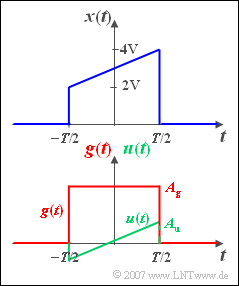Exercise 3.6: Even and Odd Time Signals
We are looking for the spectrum X(f) of the pulse x(t) sketched opposite, which rises linearly from 2V to 4V in the range from –T/2 to +T/2 and is zero outside.
The spectral functions of the signals g(t) and u(t) shown below are assumed to be known:
- The even (German: gerade) rectangular time function g(t) has the spectrum
- G( f ) = A_g \cdot T \cdot {\mathop{\rm si}\nolimits}( { {\rm{\pi }}fT} ) \hspace{0.3cm} {\rm{with}}\hspace{0.3cm} {\mathop{\rm si}\nolimits}( x ) = {\sin ( x )}/{x}.
- The spectrum of the odd (German: ungerade) function u(t) is:
- U( f ) = - {\rm{j}} \cdot \frac{ {A_u \cdot T}}{ {2{\rm{\pi }}fT}}\big[ {{\mathop{\rm si}\nolimits} ( { {\rm{\pi }}fT} ) - \cos ( { {\rm{\pi }}fT} )} \big].
Hints:
- This exercise belongs to the chapter Fourier Transform Theorems.
- All the theorems presented here are illustrated with examples in the (German language) learning video
Gesetzmäßigkeiten der Fouriertransformation ⇒ "Regularities to the Fourier transform". - Solve this task with the help of the Assignment Theorem.
- For the first two subtasks use the signal parameters A_u = 1\,\text{V} and T = 1\,\text{ms}.
Questions
Solution
- U( {f = 0.5\;{\rm{kHz}}} ) = - {\rm{j}} \cdot \frac{ {A_u \cdot T}}{ {\rm{\pi }}} \cdot {\mathop{\rm si}\nolimits} ( {{ {\rm{\pi }}}/{2}} ) = - {\rm{j}} \cdot \frac{2}{ { {\rm{\pi }}^{\rm{2}} }} \cdot A_{\rm u} \cdot T.
- The imaginary part is {\rm Im}[U(f=0.5 \,\text{kHz})]\; \underline{\approx 0.2 \,\text{mV/Hz}}.
- In contrast, the \rm si–function at f \cdot T = 1 yields the value zero, while the cosine is equal to -1. Thus with A_u = 1\,\text{V} and T = 1\,\text{ms} one obtains:
- U( {f = 1\;{\rm{kHz}}} ) = {\rm{j}} \cdot \frac{ {A_{\rm u} \cdot T}}{ { {\rm{2\pi }}}} \hspace{0.3 cm} \Rightarrow \hspace{0.3 cm} {\rm Re} [\text{...}] \hspace{0.15 cm}\underline{ = 0}, \hspace{0.3 cm}{\rm Im} [\text{...}] \hspace{0.15 cm}\underline{\approx 0.159 \;{\rm{mV/Hz}}}.
(2) According to the "Assignment Theorem", an odd time function u(t) always has an imaginary and at the same time odd spectrum U( { - f} ) = - U( f ). With the boundary transition f \rightarrow \infty follows from the given equation
- U( f ) = - {\rm{j}} \cdot \frac{ {A_u \cdot T}}{ {2{\rm{\pi }}fT}}\big[ { {\mathop{\rm si}\nolimits} ( {{\rm{\pi }}fT} ) - \cos ( { {\rm{\pi }}fT} )} \big]
the result U(f = 0) = 0. Formally, one could confirm this result by applying l'Hospital's rule.
We proceed a little more pragmatically.
- For example, if we set f \cdot T = 0.01, we obtain:
U( {f \cdot T = 0.01}) = -{\rm{j}} \cdot \frac{ {A_{\rm u} \cdot T}}{{0.02{\rm{\pi }}}}\big[ {{\mathop{\rm si}\nolimits} ( {0.01{\rm{\pi }}} ) - \cos ( {0.01{\rm{\pi }}} )} \big ] = - {\rm{j}} \cdot \frac{ {A{\rm u} \cdot T}}{{0.02{\rm{\pi }}}}( {0.999836 - 0.999507} ) \approx - {\rm{j}} \cdot 5 \cdot 10^{ - 6} \;{\rm{V/Hz}}{\rm{.}}
- For even smaller frequency values, the result also becomes smaller and smaller.
- You get to the result U(f = 0)\;\underline{ = 0} more quickly if you take into account that the integral over u(t) disappears.
- So you don't have to calculate at all.
(3) The signal x(t) can be divided into an even and an odd part, which lead to the even real part and the odd imaginary part of X(f) :
- The even part is equal to the function g(t) with A_g = 3\,\text{V}. From this follows for the real part of the spectral value at f \cdot T = 0.5:
- {\mathop{\rm Re}\nolimits} \left[ {X( {f \cdot T = 0.5} )} \right] = A_{\rm g} \cdot T \cdot {\mathop{\rm si}\nolimits} ( {{ {\rm{\pi }}}/{2}} ) \hspace{0.15 cm}\underline{= 1.91 \;{\rm{mV/Hz}}}{\rm{.}}
- The imaginary part results from the spectral function U(f) with A_u = 1\,\text{V}. This was already calculated in subtask (1):
- {\mathop{\rm Im}\nolimits} \left[ {X( {f \cdot T = 0.5} )} \right] \hspace{0.15 cm}\underline{\approx - 0.2 \;{\rm{mV/Hz}}}{\rm{.}}
